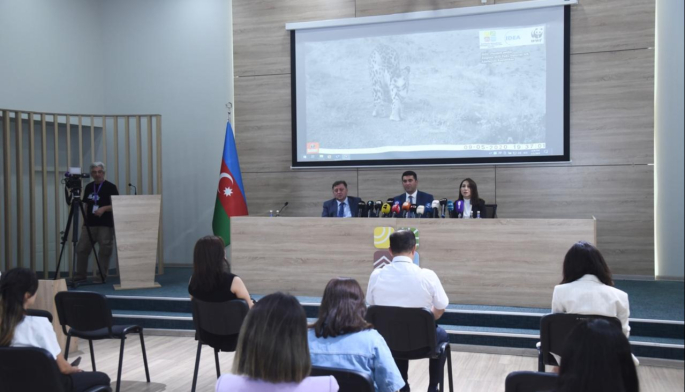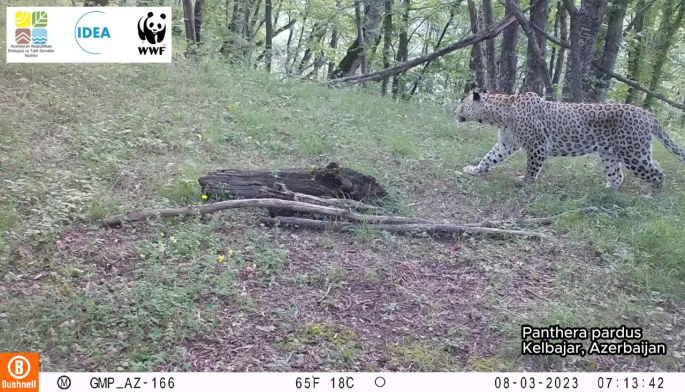Qarabağda, Kəlbəcər istiqamətində bəbir müşahidə olunub
03 İyul 2024, 15:45
Son dövrlərdə, yəni işğaldan sonra bəbirləri ilk müşahidə edən əsgərlər olub. Bundan sonra ETSN, İDEA İctimai Birliyi və WWF tərəfindən aparılmış mütəmadi izləmələr və monitorinqlər nəticəsində Kəlbəcər rayonunda bəbirin yüksək keyfiyyətli foto və videosu əldə edilib. Bunu Ümumdünya Təbiəti Mühafizə Fondu Azərbaycan nümayəndəliyinin (WWF) direktoru Elşad Əsgərov, "Azərbaycanda bəbirlərin populyasiyası, bioloji müxtəlifliyin bərpası istiqamətində görülən işlər və ekoloji turizmin inkişafına dair planlaşdırma" mövzusunda ETSN-də keçirilən mətbuat konfransında açıqlayıb.
“Qeyd edim ki, bəbirin təbii qidası olan bezoar keçilərinin bu ərazilərdə sıx məskunlaşması da bu nadir növün Qarabağda yayılmasının əsas şərtlərindəndir. Qarabağ vulkanik yaylasında həm də ən qədim zamanlardan bəri bəbirlərə rast gəlinib”.
E.Əsgərovun sözlərinə görə, Azərbaycanda bəbir fərdlərinə rast gəlindiyi əsas ərazilər Zəngəzur və Talış dağlarıdır. Qarabağda, Kəlbəcər istiqamətində bəbirlərin müşahidə olunması, həmçinin Mingəçevir gölü ətrafındakı boz dağlarda, Böyük Qafqazda onların görünməsi bəbir populyasiyasının bərpası, onların mühafizəsi, arealının genişləndirilməsi istiqamətində Azərbaycan hökümətinin, o cümlədən Ekologiya və Təbii Sərvətlər Nazirliyinin məqsədyönlü fəaliyyətinin nəticəsidir.
“Ölkəmizdə bioloji müxtəlifliyin bərpası və inkişafı üçün münbit şəraitin olması bizdə belə qənaət və əminlik yaratmışdı ki, Qarabağ bölgəsində, Kəlbəcərdə də bəbirlərə rast gəlinəcək və apardığımız monitorinqlər nəticəsində bu təsdiq olundu”.
E.Əsgərovun sözlərinə görə, bəbirlərin monitorinqinə ölkəmizdə 2002-ci ildən başlanılıb, ilk dəfə fototələ vasitəsilə 2007-ci ildə Talış dağlarında, 2012-ci ildə isə Zəngəzurda bəbirlər qeydə alınıb ki, bu da Azərbaycanda təbii şəraitdə çəkilmiş ilk bəbir fotolarıdır.
"Bu günə qədər monitorinqlər nəticəsində Naxçıvanda 9 yetkin fərd və 9 bala, Hirkan meşələrində isə 8 yetkin fərd, 2 bala fotosu çəkilib. Həyata keçirilən intensiv mühafizə tədbirlərinin nəticəsidir ki, bəbir balalarının dünyaya gəlməsi Qafqazda yalnız Azərbaycanda müşahidə olunub. Bizim ərazimizdə doğulub böyüyən balalar sonra qonşu dövlətlərin ərazisinə yayılır. Onlardan ikisi, hətta Türkiyə ərazisində müşahidə edilib, biri isə lap Qaradəniz hövzəsinə qədər gedib çıxıb".
E.Əsgərov bildirib ki, ötən əsrdə antropogen təsirlərdən bütövlükdə regionumuzda bəbirlərin sayı kritik həddə azalaraq, nəsli kəsilmək təhlükəsi ilə üzləşmişdi.
“Bəbirlər ən qədim dövrlərdən Azərbaycan ərazisində yaşayıb. Bəbirlərin qlobal arealı isə Afrika və Asiyanı əhatə edir. Azərbaycan bu arealın şimal kənarındadır. Bəbir qalıqları Azərbaycanda 400-300 min il əvvəlki torpaq qatlarında tapılıb, Qobustan, Gəmiqaya, Dəlidağ qayalarında da onun qayaüstü təsvirləri aşkar edilib.
Qobustanın qədim insan məskənində isə hepard və bəbirin kəllə sümüklərinə rast gəlinib. Bu növ vaxtilə ölkəmizin, demək olar hər yerində yaşayıb. Son illərin müşahidələri göstərir ki, Azərbaycanda bəbir populyasiyasının inkişaf dinamikasına nail ola bilmişik”.
A leopard was observed in Karabakh, in the direction of Kalbajar.
Recently, after liberation of the territories, soldiers were the first to observe leopards. Following this, regular tracking and monitoring conducted by the Ministry of Ecology and Natural Resources of Azerbaijan, IDEA Public Union, and WWF resulted in high-quality photos and videos of leopards in the Kalbajar region. Elshad Askerov, director of the Azerbaijan office of the World Wide Fund (WWF), announced this at a press conference held at the MENR on the topic "Leopard Population in Azerbaijan: Efforts in Biodiversity Restoration and Ecotourism Development."
"Let me note that the dense population of bezoar goats, which are the natural prey of leopards, in these areas is one of the main conditions for the spread of this rare species in Karabakh. Leopards have been found in the Karabakh volcanic plateau since ancient times."
According to Elshad Askerov, the Zangezur and Talish mountains are the main areas where leopards are found in Azerbaijan. The observation of leopards in Karabakh, in the direction of Kalbajar, as well as their appearance in the gray mountains around Lake Mingachevir in the Greater Caucasus, is the result of the purposeful activity of the government of Azerbaijan, including the Ministry of Ecology and Natural Resources, in restoring the leopard population, protecting it, and expanding its range.
"The presence of fertile conditions for the restoration and development of biological diversity in our country made us confident that leopards would be found in the Karabakh region and in Kalbajar, and this was confirmed as a result of our monitoring."
According to Elshad Askerov, monitoring of leopards in our country began in 2002. Leopards were first recorded in the Talish mountains in 2007 and in Zangezur in 2012, which are the first photos of leopards taken in natural conditions in Azerbaijan.
"To date, as a result of monitoring, 9 adults and 9 cubs have been photographed in Nakhchivan, and 8 adults and 2 cubs have been photographed in the Hirkan forests. Due to intensive conservation measures, the birth of leopard cubs has been observed only in Azerbaijan in the Caucasus. The cubs born and raised in our territory later spread to neighboring countries. Two of them were even observed in Turkey, and one traveled all the way to the Black Sea basin."
Elshad Askerov said that in the last century, due to anthropogenic effects, the number of leopards in our region decreased to a critical level and faced the threat of extinction.
"Leopards have lived in Azerbaijan since ancient times. The global range of leopards includes Africa and Asia. Azerbaijan is on the northern edge of this range. Leopard remains were found in soil layers dating back 400,000-300,000 years in Azerbaijan, and petroglyphs of leopards were found on the rocks of Gobustan, Gamigaya, and Dalidag.
Cheetah and leopard skulls were found in the ancient human settlement of Gobustan. This species once lived almost everywhere in our country. Observations in recent years show that we have managed to achieve the development dynamics of the leopard population in Azerbaijan."
A leopard was observed in Karabakh, in the direction of Kalbajar.
Recently, after liberation of the territories, soldiers were the first to observe leopards. Following this, regular tracking and monitoring conducted by the Ministry of Ecology and Natural Resources of Azerbaijan, IDEA Public Union, and WWF resulted in high-quality photos and videos of leopards in the Kalbajar region. Elshad Askerov, director of the Azerbaijan office of the World Wide Fund (WWF), announced this at a press conference held at the MENR on the topic "Leopard Population in Azerbaijan: Efforts in Biodiversity Restoration and Ecotourism Development."
"Let me note that the dense population of bezoar goats, which are the natural prey of leopards, in these areas is one of the main conditions for the spread of this rare species in Karabakh. Leopards have been found in the Karabakh volcanic plateau since ancient times."
According to Elshad Askerov, the Zangezur and Talish mountains are the main areas where leopards are found in Azerbaijan. The observation of leopards in Karabakh, in the direction of Kalbajar, as well as their appearance in the gray mountains around Lake Mingachevir in the Greater Caucasus, is the result of the purposeful activity of the government of Azerbaijan, including the Ministry of Ecology and Natural Resources, in restoring the leopard population, protecting it, and expanding its range.
"The presence of fertile conditions for the restoration and development of biological diversity in our country made us confident that leopards would be found in the Karabakh region and in Kalbajar, and this was confirmed as a result of our monitoring."
According to Elshad Askerov, monitoring of leopards in our country began in 2002. Leopards were first recorded in the Talish mountains in 2007 and in Zangezur in 2012, which are the first photos of leopards taken in natural conditions in Azerbaijan.
"To date, as a result of monitoring, 9 adults and 9 cubs have been photographed in Nakhchivan, and 8 adults and 2 cubs have been photographed in the Hirkan forests. Due to intensive conservation measures, the birth of leopard cubs has been observed only in Azerbaijan in the Caucasus. The cubs born and raised in our territory later spread to neighboring countries. Two of them were even observed in Turkey, and one traveled all the way to the Black Sea basin."
Elshad Askerov said that in the last century, due to anthropogenic effects, the number of leopards in our region decreased to a critical level and faced the threat of extinction.
"Leopards have lived in Azerbaijan since ancient times. The global range of leopards includes Africa and Asia. Azerbaijan is on the northern edge of this range. Leopard remains were found in soil layers dating back 400,000-300,000 years in Azerbaijan, and petroglyphs of leopards were found on the rocks of Gobustan, Gamigaya, and Dalidag.
Cheetah and leopard skulls were found in the ancient human settlement of Gobustan. This species once lived almost everywhere in our country. Observations in recent years show that we have managed to achieve the development dynamics of the leopard population in Azerbaijan."
 Azərbaycan Respublikası
Azərbaycan Respublikası 
